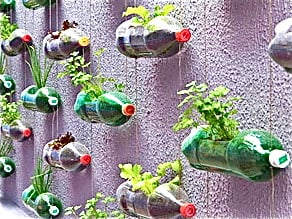Bottle gardens, as the name implies, are planted containers, usually made of glass or plastic bottles with a small opening and a narrow neck. Within the bottle, plants are cultivated with little to no exposure to the external environment. Planting in 1960 and sealing in 1972, the oldest bottle garden in existence is known to be older.
They can be highly ornamental, and having a garden in a small area is an affordable way to learn about small-scale ecologies. Since water is trapped inside the bottle and cannot evaporate, a bottle garden needs both soil and water in order for plants to survive. It also needs a water reservoir. Photosynthesis uses carbon dioxide from plant respiration, while respiration uses oxygen from photosynthesis. They consequently need very little upkeep.
A Guide to Botanical Gardening
Making it is enjoyable, inventive, and simple. You can use a recycled bottle as a makeshift greenhouse.
Choose a bottle that will accommodate the growth of plants; it should be quite large. The bigger the opening, the simpler it will be to maintain the garden. Wash the bottle and let it dry.
To create the foundation of the bottle garden, turn the bottle upside down.
Add Sand And Pebbles To The Bottle’s Base: To give the plants a better drainage base, add sand and pebbles to the bottle base and stir them around with little spoons. Before placing, moisten the sand.
- Decomposition-related odors within the bottle can be reduced by covering the drainage layer with a thin layer of activated charcoal.
- Sphagnum moss added in another thin layer will keep the soil from settling into the drainage layer.
Add Soil to Cover Sand and Pebbles: The soil needs to be well-drained and of a high quality.
Create a Garden: Select small indoor plant seeds. Using chopsticks, tweezers, or a long, thick stick, plant the seeds in the ground. To create an eye-catching arrangement, scatter the seeds in different places.
- Because the bottle will hold moisture, bottle gardening works well for plants that need a lot of humidity, such as tropical plants.
- Plants with different needs should not be mixed together, especially when it comes to watering them. For example, planting a thirsty plant next to a cactus will require more upkeep.
- It is also possible to create an underwater bottle garden.
Keep An Eye on the Plants: Take Care of them as they Get Older. Air and moisture are necessary for the plants. Make sure to puncture the bottle or jar’s lid or cap, or do not put it on at all. Fill the bottle with moisture using a water sprayer. when the glass shows no signs of condensation, only water. Avoiding the growth of mold or fungus is always preferable to submerging yourself in water.
53 Year Old Bottle Garden: Gardener David Latimer, 80, from Cranleigh in Surrey, first panted his bottle garden in 1960 and finally sealed it tightly shut 12 years later – yet its still going strong.
In 1960, David Latimer planted his bottle garden, and it remained unwatered until 1972, when he sealed it tightly as a test project.
- The barely noticeable spiderworts inside have expanded to fill the 10-gallon container, all thanks to their complete reliance on recycled water, nutrients, and air.
- Gardeners Question Time expert says it is a great example just how pioneering plants can be.


















